
2009 4th Issue
Feature Articles
I. Food Safety Seminar for Trade cum Food Safety Charter 2009 Presentation Ceremony

While there is a Chinese saying that "Food is people's paramount concern", we should pay attention to food safety when enjoying food. Therefore, although I am a food lover, I am also very careful in choosing food. I often visit the website of the Centre for Food Safety (CFS) to keep abreast of the latest information on food safety. Some time ago, I learned that a biennial Food Safety Seminar for Trade would be held by the CFS in September. The aim of the Seminar was to provide a forum for interactive exchange of information and views on important food safety issues in Hong Kong between the food trade and the Government. Hence, I talked to the chief editor and volunteered to make a report on the event.
The Seminar was held at the Lecture Theatre of Hong Kong Central Library on 17 September 2009. The officiating guest, Dr Constance CHAN, Controller of the CFS, delivered the opening speech, while a number of Government officials briefed the trade on the latest information on food safety legislation, guidelines and other related issues.
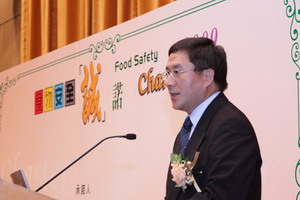
This year, special sessions were included in the Seminar to brief the trade on the "Food Safety Charter 2009" and the results of the Survey on "Five Keys to Food Safety" (Five Keys). The "Food Safety Charter 2009" Presentation Ceremony was also conducted at the same time. Officiating guests included Mr CHEUK Wing-hing, Director of Food and Environmental Hygiene, Mr WONG Yung-kan, Deputy Chairman of the Legislative Council Panel on Food Safety and Environmental Hygiene, Mr Tommy CHEUNG Yu-yan, Member of the Panel, and Dr Constance CHAN, Controller of the CFS. In his speech, Mr CHEUK commended food traders for their positive response to the promotion of the Five Keys. He said the signatories had not only pledged to disseminate the messages of the Five Keys to their staff, but also put the food safety measures into practice in their premises.
Through the "Food Safety Charter", the CFS hopes to gear up the community efforts to promote the Five Keys and enhance food safety. This year, the Charter has also introduced a recognition scheme for food trade associations and licensed food premises that sign up to the Charter for three consecutive years. The public can identify the signatories through the display of the certificate and sticker of the Charter inside their premises as well as the badges worn by their staff.
Representatives of food trade associations signed up as the signatories in the presence of the officiating guests at the Ceremony. After receiving the certificates from the guests, the signatories immediately showed them to their members and participants at the Seminar to demonstrate their determination to promote and practise the Five Keys.
21 food trade associations and over 1 700 licensed food premises / supermarkets / convenience stores signed up to the Charter this year. Information on the signatories is available at both the CFS website (www.cfs.gov.hk) and the roving exhibitions held in various districts, which is really good news for food lovers like us.
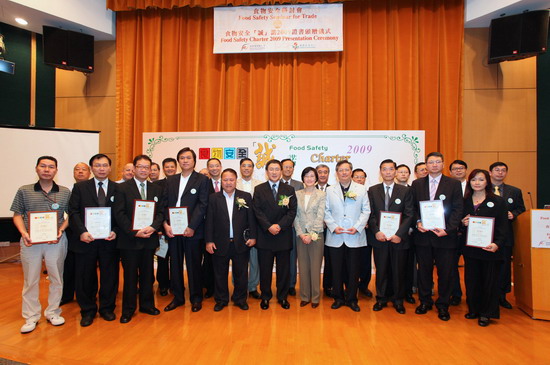
II. Supply and Sale of Safe Chinese New Year Food
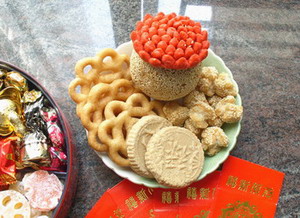 The Chinese New Year is just round the corner. Many shops will sell festive foods with good omens, such as new year cakes, deep-fried dumplings, glutinous rice dumplings, abalone and preserved pork. Good in both appearance and taste, they indeed can spice up the festival. However, if handled or stored improperly, they pose a high risk of disease. To provide safe food to customers, the food trade is advised to observe the following tips in handling and supplying festive foods.
The Chinese New Year is just round the corner. Many shops will sell festive foods with good omens, such as new year cakes, deep-fried dumplings, glutinous rice dumplings, abalone and preserved pork. Good in both appearance and taste, they indeed can spice up the festival. However, if handled or stored improperly, they pose a high risk of disease. To provide safe food to customers, the food trade is advised to observe the following tips in handling and supplying festive foods.
- Careful Selection
- Buy traditional snacks like sweetened lotus seeds and sweetened melon with natural colour and avoid those looking extraordinarily white because they may have been bleached;
- Avoid buying melon seeds that are too glossy as mineral oil may have been added during the production process, which may cause gastrointestinal discomfort.
- Proper Storage
- Prepackaged puddings, sesame balls and sweets should bear proper food labels that contain the expiry date and other required information. They should be packed properly;
- Unpackaged items like crispy triangles, sesame balls, sweets and melon seeds should be kept in dry, air-tight containers;
- Dried items should be stored in a well-ventilated place and separated by category;
- Stop selling and discard any food that may have deteriorated.
- Environmental and Staff Hygiene
- Always keep the shop clean and hygienic;
- Staff should adopt good personal hygiene practices.
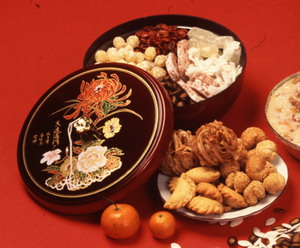
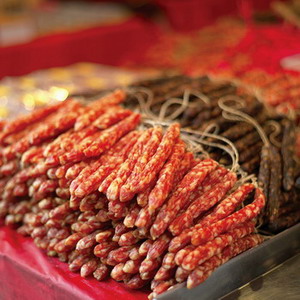
III. Ethyl Carbamate in Fermented Foods
Ethyl carbamate (EC) (also known as urethane) is naturally formed in fermented foods and alcoholic beverages during the fermentation process or during storage. Various substances derived from fermented foods and beverages, including urea, hydrogen cyanide, citrulline and other N-carbamyl compounds, are precursors of the formation of EC. The level of EC in foods depends on the amount of precursors, and will be increased with elevated temperature, presence of light and duration of storage. Variable levels of EC have been found in different fermented foods, such as bread, soy sauce and yogurt, and in alcoholic beverages, such as spirits, grape wine and beer. The International Agency for Research on Cancer assessed EC and classified it as "probably carcinogenic to humans". In that connection, the CFS conducted a study, in which the level of EC was analysed in 276 food and beverage samples including 70 alcoholic beverages.
In the analysis, EC was detected in 202 samples. Fermented soy products (fermented red bean curd, fermented bean curd) and alcoholic beverages (yellow wine, sake and plum wine) were among the food items found with relatively high EC levels, while other fermented foods, such as fermented cereals and grains products, preserved vegetables, fermented dairy products, fermented fish products (salted fish) and fermented tea (Chinese tea), contained low or non-detectable levels.
According to the result of the study conducted by the CFS on the level of EC in local fermented foods and beverages, the food group "alcoholic beverages" was identified as the main dietary source of EC, followed by the "fermented cereals and grains products" and "legumes". For the general population, dietary exposure to EC from normal consumption of fermented foods and beverages is unlikely to pose health concern. However, for consumers with high alcoholic beverages consumption, health risk of EC cannot be ruled out.


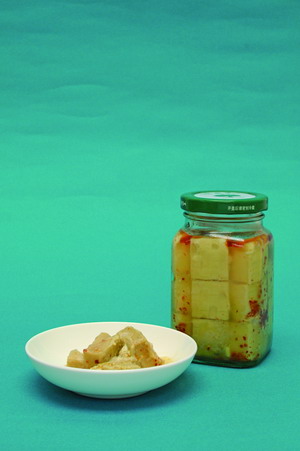
Advice to the Trade
- Manufacturers should follow Good Manufacturing Practice (GMP). Adopt mitigation measures to reduce the levels of EC in fermented foods and beverages, e.g. identifying and reducing the amount of precursors of EC.
- Use proper containers to protect fermented foods and beverages from light exposure.
- Shippers, distributors, wholesalers and retailers should minimise heat and light exposure during transportation and storage of fermented food and beverage products.
- Obtain fermented foods and beverages from reliable suppliers.
- Keep stock according to the first-in-first-out principle.
The report of the Study on Ethyl Carbamate in Local Fermented Foods is available on the CFS website:
http://www.cfs.gov.hk/english/programme/programme_rafs/files/RA39_EC_in_food_e.pdf
The CFS has formulated "Guidelines to the Trade on Reducing the Level of Ethyl Carbamate in Alcoholic Beverages during Storage and Transport", which is also available on the CFS website:
http://www.cfs.gov.hk/english/programme/programme_rafs/files/
Guidelines_on_reducing_the_Level_of_EC_e.pdf
Readers' Corner
I. How to use disposable plastic containers safely?
Frequently Asked Questions & Answers:
1. What are the disposable plastic containers used by the local food trade actually made of?
Disposable plastic containers commonly used by the food trade are often made with four types of material: polypropylene (PP), expanded polystyrene (EPS, commonly known as polyfoam), polystyrene (PS) or polyethylene terephthalate (PET).
2. How should the food trade choose disposable plastic containers?
- When choosing disposable plastic containers, take into account the characteristics of the food to be contained, such as whether the food is acidic or oily, the temperature of the food and the duration of contact.
- Obtain supportive documents that contain information or specifications on the containers, such as laboratory test reports, from the suppliers as far as possible. Study the applications and properties of the containers (e.g. their resistance to heat, acid or impact and moisture proofing ability). Ensure that the containers and their lids are suitable for their intended use.
- Inspect deliveries on receipt to ensure that the packaging is intact and there is no sign of contamination or damage to the stock.
3. What should we pay attention to when using disposable plastic containers for food packaging?
- Check whether the containers are in good conditions and discard damaged ones.
- Do not use containers with poor heat resistance properties (e.g. EPS, PS and PET) for holding foods over 100℃. Alternatively, let the foods cool down before putting them into such containers.
- Use containers with good heat resistance properties (e.g. PP containers) for holding foods over 100℃. For foods over 120℃, containers with better heat resistance properties (e.g. aluminium boxes) should be used.
- Avoid packing food too early in advance in order to shorten the time for the food being in contact with the containers.
- If the container is deformed after packing the food, stop using the container and discard the food contained.
- For the information of consumers, disposable containers containing food for sale should be marked to indicate whether they are microwave safe for reheating.

II. Points of Concern Relating to the Export of Food Products from Hong Kong to other Jurisdictions
It has recently come to the notice of the CFS that some food products exported from Hong Kong failed to comply with the relevant legislations of the importing authorities, resulting in return or destruction of the products.
At present, there is no specific requirement with regard to export of food products from Hong Kong. However, food products going into other jurisdictions must comply with the relevant legislations of the importing jurisdictions, which may be different from those of Hong Kong. The cases listed below are for reference:
Case 1
Sandwich Crackers Exported from
Hong Kong to Mainland China Found with Excessive Tartrazine and Coliform Organisms
Tartrazine -
Hong Kong: Under the Colouring Matter in Food Regulations, tartrazine is a permitted colouring matter which can generally be used in food in accordance with the Good Manufacturing Practice.
Mainland China: According to the Hygienic Standards for Uses of Food Additives, the maximum permitted level of tartrazine in sandwich middle of crackers is 50 mg/kg.
Coliform Organisms -
Hong Kong: Coliform organisms are not included in the indicator organisms of the Microbiological Guidelines for Ready-to-eat Food.
Mainland China: According to the Hygienic Standard for Biscuits, the level of coliform organisms found in biscuits should not exceed 30 MPN (most probable number)/ 100g.
Case 2
Breakfast Oatmeal with Soymilk Exported from Hong Kong to Mainland China Found With Excessive Moulds and Without Labelling of Genetically Modified Ingredients
Moulds -
Hong Kong: Moulds is not one of the microorganisms as stated in the Microbiological Guidelines for Ready-to-eat Food.
Mainland China: According to the Hygienic Standard for Breakfast Cereal, the mould count in cereal products should not exceed 50 cfu (colony forming unit)/100g.
Genetically Modified Ingredients -
Hong Kong: Under the Guidelines on Voluntary Labelling of Genetically Modified Food, any food items with 5% or more genetically modified materials in their respective food ingredient(s) should be labelled accordingly.
Mainland China: Under the Implementation Regulations on Labelling of Agricultural Genetically Modified Organisms (農業轉基因生物標識管理辦法), food items that contain genetically modified ingredients listed in the Labelling of Agricultural Genetically Modified Organisms are required to be labelled.
Case 3
Preserved Kumquat Sticks Exported from Hong Kong to Taiwan Found With Excessive Saccharin and Cyclamate
Saccharin and Cyclamate -
Hong Kong: Under the Sweeteners in Food Regulations, saccharin and cyclamate are permitted sweeteners which can generally be used in food in accordance with the Good Manufacturing Practice.
Taiwan: According to the Scope and Application Standards of Food Additives, the maximum permitted levels of saccharin and cyclamate in syrup-preserved fruits (e.g. preserved kumquat sticks) are 2 000 mg/kg and 1 000 mg/kg respectively.
The above cases show that the food ordinances of Hong Kong may be different from those of other jurisdictions. The trade is therefore advised to:
- ensure that food products for export are in compliance with the relevant legislations of the importing authorities; and
- seek advice from the relevant authorities in case of doubt.
III. Food Safety Concern over Disposable Tray Liners
Self-service fast food restaurants mostly use food trays for holding and serving food. For convenience sake, many patrons of fast food restaurants often place their food, such as French fries, or sauce, such as ketchup, directly on the tray liners. However, the elaborate print on these tray liners may contaminate food and even cause adverse health effects on consumers.
The constituents from the tray liners, such as additives in the printing inks, may migrate into the food when they come into contact. Whether these chemicals would pose a health risk or not depends on their nature and amount migrated, as well as the amount of chemicals an exposed individual has eaten. Nevertheless, tray liners are mainly used for keeping food trays clean. The criteria for the selection of raw materials and the production of tray liners may differ from those for food packaging materials or containers. Therefore, food should not be placed directly on tray liners.
Although there is no specific legislation governing the use of food contact materials or tray liners in Hong Kong at present, the Public Health and Municipal Services Ordinance (Cap. 132) stipulates that all food offered for sale in Hong Kong must be fit for human consumption. Should the food be rendered unfit for human consumption due to contamination from food contact materials such as paper, containers, tableware, utensils, or packaging materials, it would be an offence to offer such food for sale.
Advice to the Trade
- Food should not be placed directly on tray liners.
- Print a warning statement on tray liners or display a warning notice in a conspicuous location in food premises, such as "Please do not put your food directly on the tray liner".
- Provide containers for dipping sauces.
- For tray liners intended for food contact use, make sure that the constituents from tray liners will not migrate into the food causing food safety or quality concerns.
- Purchase tray liners from reliable sources and maintain proper records to enable source tracing when required.
The CFS has devised the "Guidelines on the Use of Disposable Tray Liners" for the reference of the trade. For details, please visit the following website:
http://www.cfs.gov.hk/english/food_leg/files/Guidelines_Tray_liner.pdf
IV. Concern over Food Contact Materials Exported from Hong Kong to the European Union (EU)
The rapid alert notifications on food contact materials of the EU showed that there has been a growing number of non-compliance products from Hong Kong in recent years, thus arousing concern. These products include nylon kitchen ware (such as soup ladles, turners, and tongs), ceramic food ware, melamine food ware, and polyvinyl chloride (PVC) bags etc. They were alleged to release excessive amount of harmful substances mainly coming from heavy metals (e.g. lead, cadmium) in ceramic and metallic ware, and from organic matters (e.g. primary aromatic amines, formaldehyde and phthalates) in plastics. These products were also alleged to cause a higher level of contaminant migration.
As EU member states will reject the import of non-compliance products and request that they be destroyed, the trade should adhere to the relevant EU legislations when exporting food contact materials to EU member states.
Moreover, when exporting food products to EU member states, care should also be taken that the food contact materials used (e.g. packaging materials, utensils and containers etc.) are in compliance with EU standards. This is to ensure that no food safety and quality concerns will be caused by contamination from food contact materials. Further information about EU legislations on food contact materials is available on the following website: http://ec.europa.eu/food/food/chemicalsafety/foodcontact/index_en.htm
V. Sampling Plans for Suspect Food Lots and Nutrition Labelling Compliance Testing
Under the Food Surveillance Programme, the CFS collects a range of different food samples at import, wholesale and retail levels to test for microbiological and chemical hazards. Food samples will also be taken for analysis under the Food and Drugs (Composition and Labelling) (Amendment: Requirements for Nutrition Labelling and Nutrition Claim) Regulation 2008.
The sampling plans are available on the CFS websites:
http://www.cfs.gov.hk/english/programme/programme_fs/files/
sampling_plans_for_suspect_food_lots_e.pdf
and
http://www.cfs.gov.hk/english/programme/programme_nifl/files/
sampling_plan_for_NL_compliance_testing_e.pdf


Critical Control Point of Preparing Satay Beef and Mung Bean Vermicelli Casserole (for Food Trade)
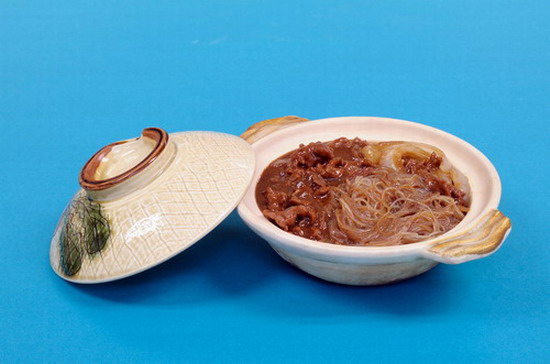
As it is getting cold, many people enjoy eating casserole dishes, which are served in different styles in many restaurants. We would like to introduce the critical control points of preparing Satay Beef and Mung Bean Vermicelli Casserole this time. While the appearance, smell and taste of the food are matters to be taken into account, we should at the same time ensure food safety so that the customers can enjoy the food safely.
| Ingredients | ||
| Fresh beef | 150 grams (about 4 taels) | |
| Mung bean vermicelli | 50 grams (about 1 tael) | |
| Onion | 1/2 piece | |
| Seasoning | ||
| Light soy sauce | 1 teaspoon | |
| Corn flour | 1 teaspoon | |
| Sugar | 1 teaspoon | |
| Pepper powder | a little | |
| Satay sauce | 2 tablespoons | |
| Dark soy sauce | 1 tablespoon |
Steps:
- Cut beef into slices. Add light soy sauce, corn flour, sugar and pepper powder. Marinate for 15 minutes.
- Soak mung bean vermicelli in boiled water until tender.
- Rinse and cut onion into strips.
- Add oil into wok. Stir fry the beef in the wok lightly. Dish up for later use.
- Preheat the casserole and add a tablespoon of oil. Add onion strips, stir fry until they smell good. Then add satay sauce, dark soy sauce and a bowl of water. Add mung bean vermicelli and beef when the water is boiling. Cook until the sauce thickens and the ingredients are thoroughly cooked.
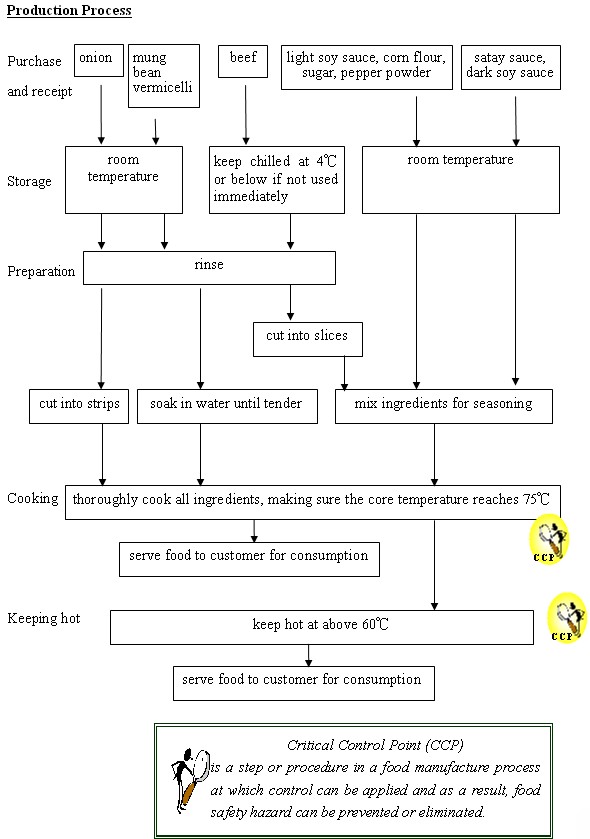
Guidelines on Production of Satay Beef and Mung Bean Vermicelli Casserole
- Purchase and receipt
- Purchase the ingredients from reliable and hygienic shops.
- When buying and receiving the ingredients, make sure that:
- the ingredients are fresh and wholesome.
- the fresh beef is purchased from a licensed fresh provision shop.
- the onion is neither damaged nor bruised on the surface.
- prepackaged food items (e.g. mung bean vermicelli, satay sauce) are used before the expiry date.
- Storage
- Store the ingredients at safe temperature as soon as possible.
- Beef not for immediate use should be stored in a refrigerator. The temperature inside the refrigerator should be checked and recorded regularly with a thermometer to ensure that the fridge remains at 4℃ or below.
- Raw beef should be stored in a container with a lid and put under cooked food or ready-to-eat food to avoid cross-contamination. Raw food and cooked food should most preferably be stored in different refrigerators.
- Practise the first-in-first-out principle for storage. Check and record the storage date of the ingredients.
- Store the ingredients at safe temperature as soon as possible.
- Preparation
- Before cooking, wash all food contact surfaces (including worktops, chopping boards and utensils) thoroughly.
- Before cooking / in the course of preparing food, wash hands thoroughly with running tap water and liquid soap.
- Use two different sets of utensils (including knives, chopping boards, bowls and chopsticks) to handle raw food and cooked food separately.
- Before cooking, rinse the beef, mung bean vermicelli and onion.
- Marinated beef not for immediate cooking should be stored in a refrigerator at 4℃ or below.
- Cooking
- The food should be thoroughly cooked before consumption until the meat juice becomes clear and not red.
- Use a clean food thermometer to measure the core temperature of the food, which should reach at least 75℃. (CCP)

- Keeping hot / Consumption
- The cooked food should be served to customers for consumption as soon as possible. It should not be kept at room temperature for more than 2 hours.
- The cooked food not for immediate consumption should be kept hot at above 60℃.

- Management System
- Implement a preventive food safety management system (such as the Hazard Analysis Critical Control Point) to identify and control any food safety problems that may emerge during production.
Food News
Turn and Look for Healthier Food Choices
Nutrition Labelling Series - Nutrient Reference Value
With effect from 1 July 2010, the actual values of energy and seven specified nutrients (i.e. protein, total fat, saturated fat, trans fat, carbohydrates, sugars and sodium) must be provided in nutrition labels. In addition, food manufacturers can voluntarily present the energy and nutrition contents in a relative amount expression. In this issue, we will focus on the questions concerning the "Nutrient Reference Value" (NRV).
Q1: How to establish the "NRV"?
"NRVs" are derived for nutrition labelling purposes. The CFS recommends the trade to adopt the "Chinese NRV" as a reference value. The "Chinese NRV" is derived from recommended intake levels of various nutrients for a healthy diet based on a 2000-kilocalorie diet.
Q2: Why do different countries adopt different sets of "NRVs"?
As some of the prepackaged food products available in Hong Kong are imported from overseas countries, some of these products may use different sets of "NRVs", such as Daily Value (DV) adopted in the United States or Daily Intake (DI) in Australia.
Q3: Are there any difference in "NRVs" among different countries?
Based on the public health conditions and criteria for setting "NRVs" in different countries, "NRVs" adopted by individual country may differ. For example:
|
Carbohydrates (g)
|
Total fat (g)
|
Sodium (mg)
|
|
|---|---|---|---|
| Chinese NRV |
300
|
60
|
2 000
|
| Daily Value adopted by United States |
300
|
65
|
2 400
|
| Daily Intake adopted by Australia |
310
|
70
|
2 300
|
Q4: What is the difference between "%NRV" and "NRV"?
"% NRV" refers to the expression of nutrient contents in a specific amount of food on the basis of percentage of "NRV", usually ranging from 0% to 100%. Take a carton of milk beverage containing 130 mg sodium as an example, the amount of sodium is equivalent to 7% of the "Chinese NRV".
Q5: How to apply "%NRV"?
A high "%NRV" means the food contains a lot of a nutrient whereas a low "%NRV" means it contains just a little. A general and simple rule is to look for food that has lower "%NRV" for nutrients that you need to limit (e.g. total fat, saturated fat, sodium and sugars), and higher "%NRV" for nutrients that are good for your health (e.g. dietary fibre).
Q6: As food manufacturers may use different sets of "NRVs" adopted by different countries, the same nutrient value may express as different "%NRVs". In this case, how should various "%NRV" be applied?
Though the "NRVs" of the same nutrient may differ among countries, you can still follow the simple rule mentioned in the Answer of Question 5. In addition, whenever using the information on nutrition labels, besides referring to the relevant percentage, the best practice is to check the actual nutrition contents to get a nutritional overview of the product and make healthy food choices.
Briefing of Activities
I. Efforts of the Centre for Food Safety in the East Asian Games
The Fifth East Asian Games (EAG) which lasted for nine days had been held between 5 and 13 December 2009. It hosted 22 sports events in 22 competition venues across 11 districts. To cope with the operation of the EAG and to ensure food safety during the events, the CFS set up a Food Safety Advisory Team comprising of specialists in August. Recommendations were made by the Team to the food trades, which included hotels, restaurants and caterers to assist them in implementing a Food Safety Plan based on the principles of the Hazard Analysis and Critical Control Point (HACCP) System. The CFS had also taken an array of measures, such as conducting surveillance and inspections on food suppliers, providing training on food safety for their staff and taking food samples for microbiological and chemical testing, with a view to enhancing food safety.
II. Frequently Asked Questions on Nutrition Labelling
To make it easier for the trade to search for information on nutrition labelling, the CFS has updated the dedicated web page for the trade in respect of nutrition labelling. The information provided on the web page includes the Technical Guidance Notes on Nutrition Labelling and Nutrition Claims and other technical documents, information on application for exemption under the Small Volume Exemption Scheme, Nutrition Label Calculator, and frequently asked questions on the Nutrition Labelling Scheme, etc. A new batch of 32 frequently asked questions on nutrition labelling have also been uploaded.
The relevant information is available on this web page:
http://www.cfs.gov.hk/english/programme/programme_nifl/programme_nifl.html
Legislation
I. Preservatives in Food Regulations
To tie in with the latest developments in food science and technology and to keep abreast of international standards, the Government tabled the Preservatives in Food (Amendment) Regulation 2008 (Amendment Regulation) at the Legislative Council in April 2008. The Amendment Regulation having been enacted by the Legislative Council will take effect on 1 July 2010. During the transitional period between the enactment of the Amendment Regulation and the date when the Amendment Regulation comes into force, it is legally in order for the trade to follow either the existing Regulation or the Amendment Regulation. The amendments include the amendment of the definition of antioxidant and the adoption of the principles of the Food Category System in the regulation of preservatives in food. The Amendment Regulation will not only provide the trade with clearer information in the use of preservatives and antioxidants, but also enable the Government to use internationally recognised risk assessment and management principles to continue to protect public health and enhance customer confidence in food safety.
Although at the permitted level of use and under normal level of consumption, food containing preservatives and antioxidants would not lead to health problems, people with allergic conditions, such as asthma patients, may experience hypersensitive reaction to certain preservatives such as sulphur dioxide in food. Such consumers should read the ingredient list when buying food to see whether those preservatives or anti-oxidants that they are allergic to are used in the food.
Details of the Regulations are available on this web page:
http://www.cfs.gov.hk/english/food_leg/food_leg_pf.html#pf_section3
II. Harmful Substances in Food Regulations
The Harmful Substances in Food Regulations made under the Public Health and Municipal Services Ordinance (Cap. 132) regulates harmful substances in food. The Regulations prescribe the maximum concentrations of various harmful substances in food and specify the substances prohibited for use in food. An offender is liable to a maximum fine of $50,000 and imprisonment for six months.
In light of the melamine incident last year, the Government made a legislative amendment to the Regulations. On 23 September 2008, the Harmful Substances in Food (Amendment) Regulation 2008 was published in the Gazette to control the use of melamine in food.
Details of the Regulations are available on this web page:
http://www.cfs.gov.hk/english/food_leg/food_leg_hs.html#hs_reg3